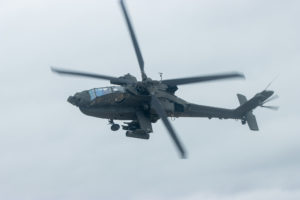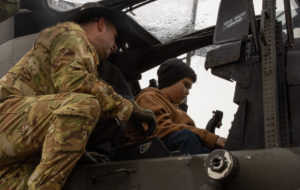Story by U.S. Army Sgt. Alex Romey
The 1st Air Cavalry Brigade “Air Cav,” 1st Cavalry Division conduct aerial gunnery exercises to ensure they have proficient and well-trained aircrews throughout January and February, at Fort Hood, TX.
Aviation gunnery trains individuals, crews, and pilots on aviation proficiency, resupplying and refueling aircraft while validating the operational readiness of the unit. The Brigade has been conducting various day-and-night tables to prove the capability of First Team Troopers.
“The 1st Air Cavalry Brigade is conducting aerial gunnery operations to ensure that our pilots, crew members, and Troopers are trained and disciplined in their profession,” Capt. Alyena Colbrook, UH-60 Black Hawk pilot, said. “Conducting this training builds a cohesive team and strengthens unit readiness.”
Troopers from across the brigade including pilots, mechanics, fuelers, medics, and downed aircraft recovery teams are perfecting their skills after recently returning from their deployments to Europe and the Middle East.
“Readiness is always at the top of our mind,” 1st Lt. Joshua Fernquist, AH-64 Apache pilot and platoon leader for Bravo Company, 1-227th Attack Battalion, said. “We just got back from Iraq, and we’re right back into the swing of it right now.”

The exercise included AH-64 Apache’s, UH-60 Black Hawks and CH-47 Chinooks performing various tables while being rearmed, refueled, and repaired with ground crews located at the Forward Arming and Refueling Points in the Fort Hood training area.
“One of the reasons why I and all the other aviators are always studying is because we need to make sure that we are absolutely the most professional aviators that the military has to offer anywhere in the world,” Fernquist said. “So we need to make sure that we have a great understanding of situational awareness.”
Army aviators spend time studying for their next gunnery table, delving into various field manuals, advanced tactical planners, and Federal Aviation Administration regulations. Both pilots and joint terminal attack controllers (JTACs) participate in after-action reviews for each table, allowing them to evaluate the success of the scenario and provide feedback.
The brigade also hosted a unit family day to showcase the various vehicles and equipment used throughout gunnery,

with First Team families given the opportunity to watch a live-fire exercise of an AH-64 Apache. The 1st Air Cavalry Brigade remains committed to providing the finest military aviators and ground crews within the U.S. Armed Forces.
